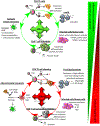Type I Interferon in Chronic Virus Infection and Cancer
- PMID: 28579323
- PMCID: PMC8059441
- DOI: 10.1016/j.it.2017.05.005
Type I Interferon in Chronic Virus Infection and Cancer
Abstract
Type I interferons (IFN-Is) are emerging as key drivers of inflammation and immunosuppression in chronic infection. Control of these infections requires IFN-I signaling; however, prolonged IFN-I signaling can lead to immune dysfunction. IFN-Is are also emerging as double-edged swords in cancer, providing necessary inflammatory signals, while initiating feedback suppression in both immune and cancer cells. Here, we review the proinflammatory and suppressive mechanisms potentiated by IFN-Is during chronic virus infections and discuss the similar, newly emerging dichotomy in cancer. We then discuss how this understanding is leading to new therapeutic concepts and immunotherapy combinations. We propose that, by modulating the immune response at its foundation, it may be possible to widely reshape immunity to control these chronic diseases.
Keywords: CD4 T cell; CD8 T cell; HCV; HIV; LCMV; T cell exhaustion; cancer; chronic virus; dendritic cell; immune activation; immunotherapy; innate immunity; interferon alpha; interferon beta; macrophage; persistent virus; tumor; type I interferon.
Copyright © 2017 Elsevier Ltd. All rights reserved.
Figures

References
-
- de Weerd NA et al. (2013) Structural basis of a unique interferon-beta signaling axis mediated via the receptor IFNAR1. Nat. Immunol 14, 901–907 - PubMed
Publication types
MeSH terms
Substances
Grants and funding
LinkOut - more resources
Full Text Sources
Other Literature Sources
Medical
Research Materials

